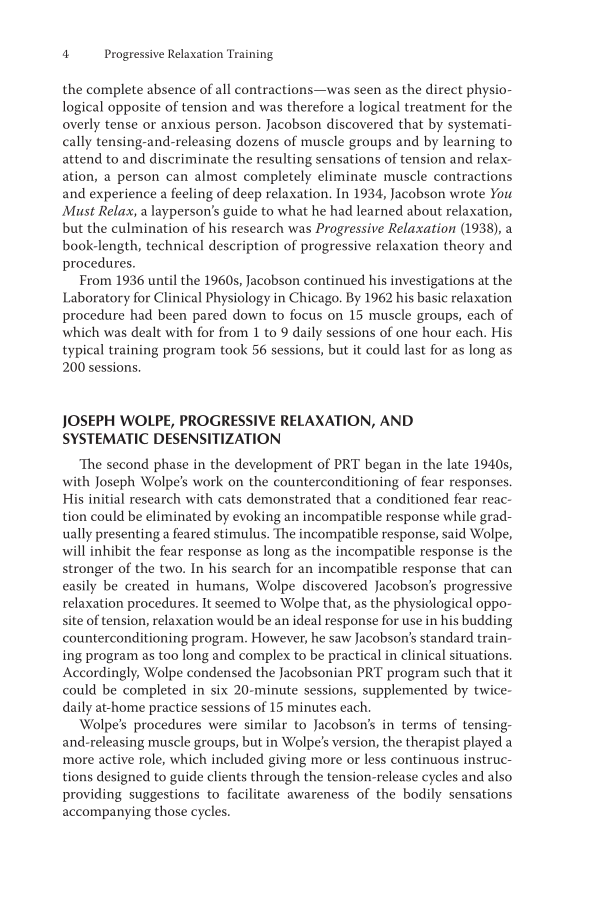4 Progressive Relaxation Training the complete absence of all contractions—was seen as the direct physio- logical opposite of tension and was therefore a logical treatment for the overly tense or anxious person. Jacobson discovered that by systemati- cally tensing-and-releasing dozens of muscle groups and by learning to attend to and discriminate the resulting sensations of tension and relax- ation, a person can almost completely eliminate muscle contractions and experience a feeling of deep relaxation. In 1934, Jacobson wrote You Must Relax, a layperson’s guide to what he had learned about relaxation, but the culmination of his research was Progressive Relaxation (1938), a book-length, technical description of progressive relaxation theory and procedures. From 1936 until the 1960s, Jacobson continued his investigations at the Laboratory for Clinical Physiology in Chicago. By 1962 his basic relaxation procedure had been pared down to focus on 15 muscle groups, each of which was dealt with for from 1 to 9 daily sessions of one hour each. His typical training program took 56 sessions, but it could last for as long as 200 sessions. JOSEPH WOLPE, PROGRESSIVE RELAXATION, AND SYSTEMATIC DESENSITIZATION The second phase in the development of PRT began in the late 1940s, with Joseph Wolpe’s work on the counterconditioning of fear responses. His initial research with cats demonstrated that a conditioned fear reac- tion could be eliminated by evoking an incompatible response while grad- ually presenting a feared stimulus. The incompatible response, said Wolpe, will inhibit the fear response as long as the incompatible response is the stronger of the two. In his search for an incompatible response that can easily be created in humans, Wolpe discovered Jacobson’s progressive relaxation procedures. It seemed to Wolpe that, as the physiological oppo- site of tension, relaxation would be an ideal response for use in his budding counterconditioning program. However, he saw Jacobson’s standard train- ing program as too long and complex to be practical in clinical situations. Accordingly, Wolpe condensed the Jacobsonian PRT program such that it could be completed in six 20-minute sessions, supplemented by twice- daily at-home practice sessions of 15 minutes each. Wolpe’s procedures were similar to Jacobson’s in terms of tensing- and-releasing muscle groups, but in Wolpe’s version, the therapist played a more active role, which included giving more or less continuous instruc- tions designed to guide clients through the tension-release cycles and also providing suggestions to facilitate awareness of the bodily sensations accompanying those cycles.
Document Details My Account Print multiple pages
Print
You have printed 0 times in the last 24 hours.
Your print count will reset on at .
You may print 0 more time(s) before then.
You may print a maximum of 0 pages at a time.




































































































































































































































































